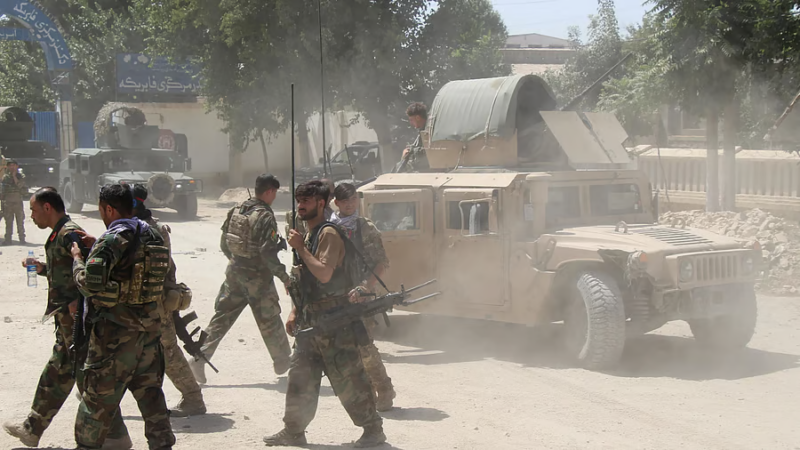Balochustan Fumes over Gwadar Fencing for China

An iron fencing running through Balochistan’s port city of Gwadar, stretching to 24 km and ending at the Arabian Sea shore is causing disquiet among the Balochi people amidst speculation that it is being built at the behest of the Chinese keen to ensure the security of their people, ships and goods and equipment.There have been public protests and a petition has been filed in the court opposing the project that is allegedly being executed “suddenly and surreptitiously,” as per media reports, without any consultations with the local authorities.
The citizenry has no role to play.It is not part of the city’s development plans. Its route is intriguing in that it will cut through dozens of dwellings as the city itself gets divided into two, one part likely to be close to the general public. Following protests, the project is said to be put on hold till further consultations. However, such a promise can hardly hold in a province is ruled with an iron hand by the federal government in Islamabad, where violence is rampant, by the military and other security forces, the Islamist militants and the local armed groups of ‘nationalist’ Balochis who are fighting the federal government since long before Pakistan entered into the China Pakistan Economic Corridor (CPEC).
A sleepy town till a few years back, Gwadar gained prominence as the southern end of the corridor that begins at Kashgar in China’s Xinjiang province 2023 km away and is China’s gateway to the Indian Ocean, notably, to the Gulf region that is the wold’s largest oil wealth. The Chinese have financed, designed, built the port opened in2016 and are now operating it. But Beijing or the CPEC do no figure officially in the fencing project.An opinion piece in Dawn (December 31, 2020) says soon after the construction of the fence was noted by locals, Senator Mir Kabir Mohammad Shahi of the National Party floated “a sinister take” at a press conference in Quetta.
He said the fence is part of an attempt to separate Gwadar from Balochistan.The newspaper quoted the ‘Independent News Pakistan’, a pro-China online news portal, ostensibly replying to the senator’s allegations, “quoted the Gwadar Port Authority chairman describing the fence as “a long proposed desire that has come true now” that will enable “a transformation of Gwadar to become safer and more secure on modern age’s demand”.The GPA official sought to justify the fence building for the sake of the Chinese workers bothered by a recent terror attack at private hotel in Gwadar. “They deserve a normal life free from all sorts of threats. After rigorous work, they need to go for outing and cherishing marvellous walk at boisterous beaches of Gwadar.
They must have an environment in which they dine outside enjoying and feasting their eyes on traditional Gwadar cuisines. They seek leisure time besides shopping spree with their families,’ he added.”Various sections of the Baloch citizenry do not buy this. They see the fence as meant to restrict their movement on their own land.The Chinese, many of whose personnel were killed while executing Gwadar, are constantly in fear of security threats. They are keeping a wary eye on the security situation in the region since three separate militant groups came under one umbrella in November 2018, and then went on to launch a series of assaults starting with the attack on the Chinese consulate in Karachi, followed by the one on the Pakistan Stock Exchange building, and then a series of small ambushes on army and FC personnel in Kech, Turbat, Panjgur, Ormara, and so on.
In the latest Mach, although 424 km away from Gwadar, witnessed the killings of a dozen coalmine workers by Sunni militants on January 3, their targets being Shia Hazara worker, heightening the security concerns in Balochistan.The secrecy surrounding the fence and much that is happening in Gwadar is the result of the Chinese sensitivity, but also the way Pakistan operates. Pakistan’s political opposition and the United States, among others, have charged that much of the CPEC project lacks transparency. Corruption charges have been made against Pakistani and Chinese officials alike.
The Dawn article by Khurram Husain says: “I have long maintained that we in Pakistan don’t have a clear idea of what exactly is being built in our country under the umbrella of CPEC. There are important gaps between what we are told is being built, and what we see coming up on the ground.”Writing in Friday Times (January 1, 2021), Adnan Amir stated: “In the second week of December, the Balochistan government suddenly began fencing Gwadar city. The plan, as told by government officials, was to fence 24 square kilometer area of Gwadar city and only allow two to three entry points. People with special permits can enter through these points, as per government plans. It was also claimed that the idea of fencing was part of the Gwadar smart city masterplan.
“This decision by the government triggered strong opposition from people across the province. A jirga held in Gwadar rejected the government’s plan to fence off the port city and termed it an attempt to restrict the entry of local people in the area. Political parties, media and civil society also questioned the rationale behind this decision. Balochistan Bar Council challenged this decision in the high court. However, some businessmen and politicians associated with the ruling party expressed support for this decision.”Gwadar is one of the many ports in the Indian Ocean region with Chinese presence in terms of money, goods and personnel. While those in Sri Lanka, Myanmar, the Maldives and Malaysia have witnessed ups and downs, its presence in Gwadar has been constant and increasing, thanks to Pakistan’s total commitment – and heavy dependence – upon the CPEC.
The role is both commercial and military, since the all-powerful Pakistan Army wants it. The Chinese, too, want Pakistan’s military to remain pro-active on CPEC. The military aspect, however, well-known to the world, is never officially admitted.“Chinese officials insist that the ports would not be militarized. But analysts began wondering whether China’s endgame was to muscle its way onto coastal territories that could become prime military assets — much as it did when it started militarizing contested islands in the South China Sea,” the New York Times wrote way back on December 19, 2018.
It said “Chinese officials have repeatedly said the Belt and Road is purely an economic project with peaceful intent. But with its plan for Pakistan, China is for the first time explicitly tying a Belt and Road proposal to its military ambitions — and confirming the concerns of a host of nations who suspect the infrastructure initiative is really about helping China project armed might.”
Detailing Chinese military plans, already implemented in parts, NYT further said: “Military analysts predict that China could use Gwadar to expand the naval footprint of its attack submarines, after agreeing in 2015 to sell eight submarines to Pakistan in a deal worth up to $6 billion. China could use the equipment it sells to the South Asian country to refuel its own submarines, extending its navy’s global reach.” (Ends)






